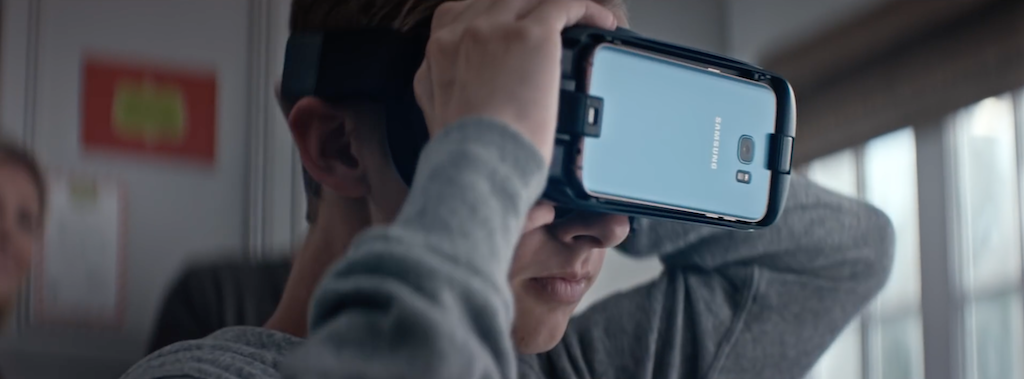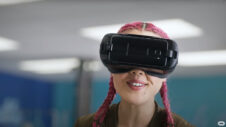When I opened the box and pulled out Samsung’s Gear VR headset, I remember putting the headset up to my face, making sure that it fit my eyes, then having this weird feeling of “this reminds me of all those infamous eye checkups I had as a kid.”
As weird as that feeling may have been, though, it makes sense. Gear VR is all about the visual experience, and you need to have either strong vision or glasses (or both, in some cases) to appreciate the view. The Gear VR headset is designed in some ways like an eye machine, but it’s designed to be fun. I don’t think I could say the same thing about annual optometrist visits or the eye machine that puffs air into your eyes.
Gear VR, as is the case with virtual reality as a whole, is expanding, but with each new generation of Gear VR (and Google’s new Daydream View, among others), I get the feeling that the mobile VR industry has yet to see two things: first, that VR headsets are wearables; second, that, as wearables, Gear VR, Daydream View, and other mobile VR headsets including Oculus Rift and the HTC Vive, should be tailored to fit consumer vision. Let me explain.
Unless you’ve been on vacation for a while or told yourself that wearables don’t exist, we’ve reached an age in technology where we not only want to use it but we want to wear it also. And, when it comes to wearables such as smartwatches, the consumer market has spoken: it wants a smartwatch that doesn’t just appear to be a large wrist computer, but rather, a smart device that is unsuspecting and unnoticeable at first glance. We want our technology to fit into the grand scheme of things, not stand out like a sore thumb.
Not only do we want our wearables to be sleek, subtle, and capable, but we also want what I call “a tailored look”: we want the ability to substitute wristbands when the occasion rises (the LG Watch Sport, apparently, is too antenna-hungry, unfortunately). We want our wearables to come in different sizes, seeing that the “one size fits all” mantra is a dream, not a reality.
We want our wearables to not only have interchangeable wristbands and come in different sizes but also survive the elements: we want to run in the rain and have fitness tracking, GPS, LTE, NFC, MST, etc., active and working so that we don’t have to take care of recording our own exercises and “guesstimating” our own distances traveled. Someday, I look forward to Samsung’s Gear smartwatch possessing the ability to perform auto water and auto caffeine tracking.
Gear VR is a wearable. Okay, it’s not quite the same as wearing a smartwatch or a fitness band, but still, it is worn on the head when you game. And, as a wearable, the experience is made or broken based on vision. The current mobile VR industry has been taking a “one vision fits all” approach to VR, providing 360-degree images in VR galleries that a nearsighted person may not be able to fully appreciate because he or she can’t see the sunset or trees in the distance. A farsighted person can’t appreciate front-row seats at the latest NBA basketball game in VR because he or she can’t see them.
If VR headsets are all about vision, and they are wearables, then, shouldn’t they have more customization to match all other wearables? Most wearables don’t need a tailored look or vision for them, but glasses do. Current headsets allow glasses to be worn, but the visual experience is still insufficient based on consumer vision: some consumers fare well, but nearsighted and farsighted VR headset wearers do not.
Google’s failed Google Glass experiment, despite where you stand on the idea, had one thing right: it had in mind a prescription-based experience where each customer’s vision would allow him or her to see adequately. VR headsets go on the head, but, like Google Glass, depend on consumer vision to flourish or perish. Gear VR will flourish or perish on a tailored look, a customizable vision-based experience, in the future.
Remember those eye checkups? Yes, I am extremely nearsighted and had many of them, but they didn’t give me nearly as much entertainment as Gear VR has. But where Gear VR can learn from them is that those checkups were designed to care about my eyes and thus, care about my visual experience. I want the Gear VR of the future to care about whether I’m nearsighted or farsighted, whether 360-degree images are too far away or too up-close, whether I want to game with my glasses on or off: a tailored look that is just perfect for me.
It’s been said that a chain is no stronger than its weakest link; but virtual reality is no stronger than its most vision-impaired participant. And as it stands currently, the results are dim.





